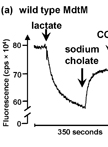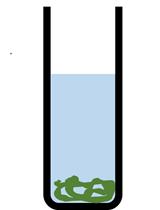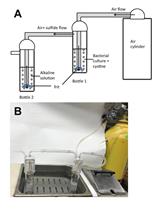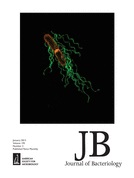- Submit a Protocol
- Receive Our Alerts
- Log in
- /
- Sign up
- My Bio Page
- Edit My Profile
- Change Password
- Log Out
- EN
- EN - English
- CN - 中文
- Protocols
- Articles and Issues
- For Authors
- About
- Become a Reviewer
- EN - English
- CN - 中文
- Home
- Protocols
- Articles and Issues
- For Authors
- About
- Become a Reviewer
Amino Acid Transport Assays in Resting Cells of Lactococcus lactis
Published: Vol 3, Iss 12, Jun 20, 2013 DOI: 10.21769/BioProtoc.793 Views: 8893

Protocol Collections
Comprehensive collections of detailed, peer-reviewed protocols focusing on specific topics
Related protocols

Measurement of Proton-driven Antiport in Escherichia coli
Scarlett R. Holdsworth and Christopher J. Law
Nov 5, 2014 9490 Views

Determination of Mn Concentrations in Synechocystis sp. PCC6803 Using ICP-MS
Fabian Brandenburg [...] Marion Eisenhut
Dec 5, 2017 8260 Views

Quantification of Hydrogen Sulfide and Cysteine Excreted by Bacterial Cells
Sergey Korshunov and James A. Imlay
May 20, 2018 6801 Views
Abstract
Many bacteria are auxotrophic for at least a number of amino acids for which they lack the biosynthetic pathways. The organisms are still able to grow in media containing free amino acids as the sole source of amino acid when transport systems for the free amino acids are present in the cytoplasmic membrane. A range of transport systems for essential as well as non-essential amino acids has been described that use the proton motive force (by proton symport) or ATP hydrolysis as driving force to allow for the accumulation of the amino acid in the cells. The most widely used assay for uptake of amino acids (or any other substrate) is the rapid filtration assay using radiolabelled substrates. Here we describe the assay for uptake in resting cells of Lactococcus lactis (L. lactis) that are energized by glucose.
Materials and Reagents
- L. lactis cells
- Whatman, Protran® BA85 Nitrocellulose Membranes (2.5 cm diameter, 0.45-μm-pore-size nitrocellulose filter ) (Sigma-Aldrich, catalog number: Z670634 )
- LiCl
- K2HPO4
- KH2PO4
- 14C-labelled amino acids (PerkinElmer)
Note: stock solutions typically contain 50-100 mCi/ml corresponding to 100 to 500 μM concentrations.
- Scintillation fluid (e.g. Emulsifier Scintillator Plus, Packard Bioscience)
- 100 mM potassium phosphate (KPi) pH 5.8 buffer at 4 °C (see Recipes)
- KPi containing 0.2% glucose at 4 °C (see Recipes)
Equipment
- Filtration setup (e.g. Ten-place filtration manifold, catalog number: FH225V )
- Vacuum pump
- Thermostat water bath with magnetic stirrer
- Liquid scintillation analyser (e.g. Tri-Carb 2000CA, Packard Instruments)
- Glass tubes (10 x 75 mm)
- Tweezers
- Magnetic stirring bars
- Timer
- Vortex
Procedure
- L. lactis cells harvested in the late exponential growth phase between OD660 of 0.6 and 1.0, washed and resuspended to OD660 of 2 in potassium phosphate (KPi) buffer, kept on ice.
- Homogenize cell suspension by briefly vortexing.
- Distribute alliquotes of 100 μl of the cell suspension over 5 glass tubes. Keep on ice.
- Incubate one of the tubes for 5 min at 30 °C under continuous stirring.
- Mount filter in setup and apply vacuum.
- At t = 0, add 1 μl of the 14C-labelled amino acid stock solution to the cells in each of the five tubes giving 1-5 μM concentrations.
- At each of the time points t = 0.5, 1, 2, 4 min, add 2 ml of ice cold 0.1 M LiCl and filtrate cells over the nitrocellulose filter. For most amino acids these four time points cover a complete uptake curve. Occasionally, other time points may have to be selected.
- Immediately rinse tube with another 2 ml of 0.1 M LiCl and filtrate over the same filter.
- Remove vacuum, and transfer filter with tweezer to a 2 ml Eppendorf tube and put a new filter back to the filtration setup for the next sample.
- For the zero time point (final tube), skip the incubation at 30 °C (step 3); add the radioactivity to the cell suspension on ice , immediately followed by 2 ml LiCl and filtration plus rinsing (steps 6 and 7). Keeping the sample on ice prevents uptake during processing of the sample.
- Add 1 μl of the 14C-labelled amino acid stock solution to a 2 ml Eppendorf tube to determine the total amount of radioactivity used per time point.
- Add 1.8 ml of scintillation fluid to the Eppendorf tubes.
- Measure radioactivity retained on the filters by scintillation counting. Best results are obtained after allowing the filter plus bacteria to dissolve in the scintillation fluid.
- Uptake (rate) can be calculated from retained activity and total added activity and expressed in nmol amino acid/(mg protein x minute). The amount of amino acid is calculated from the data provided by the manufacturer and the amount of protein determined by standard assays for cell protein.
Recipes
- 0.1 M KPi pH 5.8 buffer (1,000 ml)
Mix 1 M K2HPO4 and 1 M KH2PO4 to a final pH of 5.8 and dilute 10x with dH2O.
Mix 10 ml KPi pH 5.8 and 0.1 ml of a 20% glucose solution. Store at 4 °C.
Acknowledgments
This protocol was adapted from and recently used in Trip et al. (2013).
References
- Trip, H., Mulder, N. L. and Lolkema, J. S. (2013). Cloning, expression, and functional characterization of secondary amino acid transporters of Lactococcus lactis. J Bacteriol 195(2): 340-350.
Article Information
Copyright
© 2013 The Authors; exclusive licensee Bio-protocol LLC.
How to cite
Trip, H. and Lolkema, J. S. (2013). Amino Acid Transport Assays in Resting Cells of Lactococcus lactis. Bio-protocol 3(12): e793. DOI: 10.21769/BioProtoc.793.
Category
Microbiology > Microbial metabolism > Nutrient transport
Do you have any questions about this protocol?
Post your question to gather feedback from the community. We will also invite the authors of this article to respond.
Tips for asking effective questions
+ Description
Write a detailed description. Include all information that will help others answer your question including experimental processes, conditions, and relevant images.
Share
Bluesky
X
Copy link








